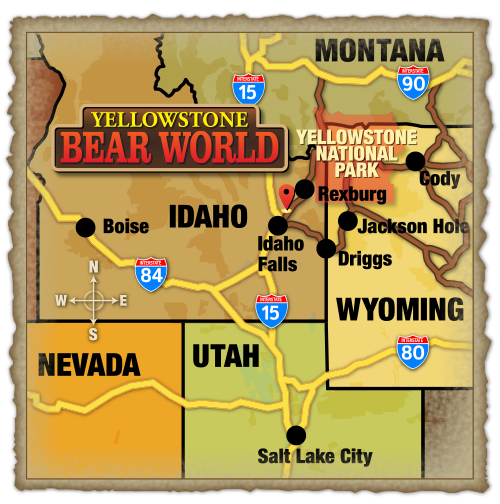Blog
Interesting Facts About Bears You Have Probably Never Heard About
Posted by Bear World on Feb 19, 2019 in Blog | Comments Off on Interesting Facts About Bears You Have Probably Never Heard About

Bears may be one of the most interesting animals to mankind. They have captivated our mental faculties for years, and some people even use bears to help with overcoming mental illnesses, such as trauma or for natural therapeutic relief. This interesting fact is just a sample of many interesting things about bears that few have realized, and our team of bear experts at Yellowstone Bear World has compiled a few of them in this article. The Spirit Bear The...
Read moreWhat You Should Know about the Weather in Yellowstone throughout the Year
Posted by Bear World on Feb 1, 2019 in Blog | Comments Off on What You Should Know about the Weather in Yellowstone throughout the Year

For those planning vacation in Yellowstone, understanding the dynamic Yellowstone weather patterns may help you plan the best time to visit and vacation at Yellowstone. Each season in the national park creates its own unique and adventurous feel, be it spring, winter, fall or summer. The ever-changing Yellowstone weather is incredible to witness, from the silver glean of newly fallen snow in the winter to the scenic fields of wildflowers in the summer. Basically, there...
Read moreIconic All-American Bears
Posted by Bear World on Nov 9, 2018 in Blog | Comments Off on Iconic All-American Bears
Bears have been one of America’s favorite animals for a long time. Perhaps this is because our country is home to a few different species of bears. Or maybe we’re fascinated by bears for the same reason we’re fascinated by sharks and lions – apex predators are undoubtedly cool and every year, lots of people come to see bears in Yellowstone. America’s love of bears has led to many different bears, some fictional and some real, ingraining themselves in our...
Read moreA Quick Guide to the Coolest Geothermal Features in Yellowstone
Posted by Bear World on Jun 19, 2018 in Blog | Comments Off on A Quick Guide to the Coolest Geothermal Features in Yellowstone

When you come to Yellowstone National Park, there’s a lot to do. Yellowstone Bear World is your best bet for safely coming up close and personal with bears in Yellowstone and other wild animals. Another thing you don’t want to miss is Yellowstone’s many geothermal features. These geysers and hot springs are one of the natural wonders of North America and a key part of what makes Yellowstone so unique. Mammoth Hot Springs When you check out Mammoth Hot Springs,...
Read more7 Facts About Yellowstone You Probably Didn’t Know
Posted by Bear World on May 15, 2018 in Blog | Comments Off on 7 Facts About Yellowstone You Probably Didn’t Know

If you’re planning a trip to Yellowstone Bear World and some of the other best Yellowstone attractions, there are some cool facts regarding the park you can learn more about before you get here. By learning about more about Yellowstone and what makes it unique, you can make your trip far more engaging and memorable. Here are a few facts you might not have known about Yellowstone: Yellowstone was the World’s First National Park Established in 1872, Yellowstone was...
Read moreHow Far Away Should I Be to See Animals in Yellowstone?
Posted by Bear World on Apr 16, 2018 in Blog | Comments Off on How Far Away Should I Be to See Animals in Yellowstone?

It is important that while you observe and enjoy wildlife in Yellowstone that you take the necessary precautions to keep you and anyone else with you safe. This includes not disturbing the wildlife and keeping a good distance from them, which distance often depends on the species you are observing. Generally, you can stand up to 25 yards from bison, moose, coyotes, and elk safely. Other animals, like bears and wolves, should be observed from a distance of 100 yards or...
Read moreWhat to Do in Yellowstone Beside Scenic Driving
Posted by Bear World on Mar 13, 2018 in Blog | Comments Off on What to Do in Yellowstone Beside Scenic Driving

One of the best Yellowstone attractions includes taking a drive along the park’s roads and viewing its picturesque scenery, but this is not the only thing to do here. There are many exciting ways to enjoy the park, including seeing bears and other animals up close at Yellowstone Bear World When you are in Yellowstone, you are in nature. You are in an undisturbed parcel of the United States’ interior that offers a wide variety of ways to enjoy what nature has to...
Read moreWhat to Do if You Accidentally Encounter a Bear in Yellowstone
Posted by Bear World on Feb 9, 2018 in Blog | Comments Off on What to Do if You Accidentally Encounter a Bear in Yellowstone

When you’re in Yellowstone National Park, there’s always the possibility you’ll run into a bear. Although you should do everything you can to avoid a bear encounter, such as traveling in groups, making noise, and avoiding bear-specific territory, you cannot completely eliminate the chance of coming close with one of these creatures while you are in the park. Being prepared for a bear encounter can help you if you ever come face-to-face with one while you are in...
Read moreThe Top Five Things to Do in Yellowstone
Posted by Bear World on Jan 30, 2018 in Blog | Comments Off on The Top Five Things to Do in Yellowstone

Every year, millions of people from around the world visit Yellowstone National Park. It is easy to see why Yellowstone is so popular with visitors – there’s no shortage of unique activities and things to do here specific to the park itself. Below are five of the most popular things to do in Yellowstone National Park. If you’re planning a trip here, take some time to learn about all the park’s attractions to put together the most enjoyable itinerary for yourself...
Read moreWhat Kinds of Animals Will I See in Yellowstone?
Posted by Bear World on Jan 9, 2018 in Blog | Comments Off on What Kinds of Animals Will I See in Yellowstone?

When visitors come to Yellowstone National Park, they come to see nature. For most visitors, that means coming face-to-face with wildlife species they have never seen before or rare animals that live only in Yellowstone’s protected forest. Yellowstone National Park exists to preserve these different types of wildlife but also provides you and your family with an opportunity to enjoy the country’s wild, open spaces as well as the animals that inhabit the park.. Come...
Read more











